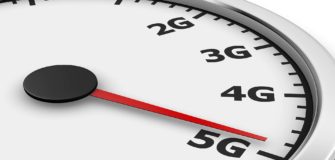At a Glance: What Is New in Wi-Fi 7?
Share

| Wi-Fi 6/6E | Wi-Fi 7 | |
| Operating bands | Tri band: 2.4 GHz, 5 GHz, 6 GHz | No change |
| Technology | Uplink/Downlink OFDMA | No change |
| MU-MIMO | Uplink/Downlink MU-MIMO | No change |
| Modulation | 1024 QAM | 4096 QAM |
| Spatial Streams | 8 | 16 |
| Bandwidth (MHz) | 20, 40, 80, 160 MHz | 20, 40, 80, 160, 320 MHz |
| Multi-Link Operation | No | Yes |
Let’s break down each new feature.
Multi-link Operation
All previous Wi-Fi technologies relied on establishing a wireless connection over a single channel, be that 2.4, 5, or 6 GHz spectrum. Wi-Fi 7 allows a client to connect to all three bands simultaneously. This feature allows for duplicate transmission/reception over multiple bands/frequencies, increasing transmission/reception reliability.
Thanks to this feature, it is now easier to balance the load in the network across multiple bands. Suppose the radio conditions change, and a channel or most of the band experiences an increased ambient noise level. In that case, the client may automatically switch to a channel or band with more favorable radio conditions. Depending on the RF channel size the switch was made to, this may or may not affect the data transmission rate, as available channel sizes differ among the three spectrum bands.
Advanced Modulation
Advanced modulation choice determines spectral efficiency, which determines data rate. The higher the QAM number, the higher the spectral efficiency and the higher the data rate. Thus, it is beneficial to have as high QAM modulation as possible. The table below shows an overview of QAM modulations and their relationship to spectral efficiency, expressed in b/s/Hz:
| Modulation Level (QAM) | Bits/Symbol/Hz |
| 4 (QPSK) | 2 |
| 8 | 3 |
| 16 | 4 |
| 32 | 5 |
| 64 | 6 |
| 128 | 7 |
| 256 | 8 |
| 512 | 9 |
| 1024 | 10 |
| 2048 | 11 |
| 4096 | 12 |
Wi-Fi 7’s highest modulation (4096 QAM) has 12 b/s/Hz, while Wi-Fi 6E has only 10 b/s/Hz. This 20% increase in spectral efficiency translates to a 20% increase in maximum achievable data rate.
However, to successfully demodulate any signal at the receiver, a minimum signal-to-noise ratio (SNR) must be achieved. The higher the modulation level, the higher the minimum SNR. For 1024 QAM, it is widely accepted that the minimum SNR = 35 dB. To illustrate coverage calculation examples, we assume 4096 QAM to be SNR = 38 dB.
Let’s assume that both the 6E and 7 protocols are active in a 160 MHz channel. The thermal noise level in such a channel is -174 + 10*log10(160,000,000) = – 92 dBm. A typical noise figure at a Wi-Fi receiver is NF = 6 dB and has to be added to thermal noise. Thus, the noise level at the receiver is -86 dBm. If the minimum SNR for 1024 QAM is SNR = 35, the minimum signal level at the receiver is -86 + 35 = – 51 dBm. For 4096 QAM, we assume SNR = 38 dB, so the minimum signal level at the receiver is -86 + 38 = -48 dBm. From this example, we see that the receiver needs a higher input signal to receive the highest modulation. This means that the receiver must be closer to the transmitter to be able to decode 4096 QAM than 1024 QAM.
How far can a client be from an AP before the signal at the client is less than -48 dBm? It all depends on AP transmit power and antenna gain. There are online tools that can calculate path loss; one example is Free Space Path Loss Calculator.
If we assume transmit power = 0 dBi, transmit antenna gain = 3 dBi, frequency of operation = 5.7 GHz, and receive antenna = 0 dBi, then path loss is 48 dBm, and the distance between AP and client is 1.5 meters. This is the maximum distance at which a 4096 QAM signal can be demodulated. By comparison, a 1024 QAM can be demodulated at a distance of 2.1 meters.
Maximum Channel Bandwidth
Wi-Fi 7 doubles the Wi-Fi 6E channel width from 160 to 320 MHz. This doubles the maximum achievable data rate. However, this does not come without a penalty. The thermal noise level increases by 3 dB every time we double the channel bandwidth. Thus, the noise level for a 320 MHz channel is -83 dBm, and, using the example above, the minimum signal level at the receiver for a 4096 QAM demodulation is -45 dBm. Using a path loss calculator above, we see that the maximum distance between the AP and client at which 4096 QAM demodulation is possible in a 320 MHz channel is 1.05 meters.
Maximum Spatial Streams
The maximum number of spatial streams doubles in Wi-Fi 7, from 8 to 16. In theory, all 16 streams can be active at the same time, each serving a unique client. If the streams do not overlap, SNR at each client will be high, and the compounded data rate delivered to the clients will be double that of 8 streams. However, this may happen only in specific deployment scenarios.
One such scenario is mounting an omnidirectional AP in the middle of the cafeteria. When the cafeteria is full, and clients are equally spaced throughout, AP has a 360-degree view of the clients in range. In that case, it is possible to have all 16 spatial streams active, non-overlapping, and serving clients. Another deployment scenario that can fully take advantage of this feature is an AP in a stadium, a convention center, or an office boardroom. In a general case, the clients would not be equally spaced, and 16 streams would rarely transmit all at once. In general, the higher the number of advertised spatial streams, the lesser the chance that the highest number of streams can be seen in most deployment scenarios.
Tying It All Together
If we only look at the specifications on paper, we expect that doubling the channel size will double the maximum data rate per stream. We also expect another data rate doubling when all 16 streams are active. Then, we expect a modest 20% gain from using higher-order modulation to get a total of a 420% increase in the maximum achievable data rate. In reality, this astounding improvement can only be experienced if we happen to have clients standing in a circle directly below an AP, about a meter away.
In reality, most of the APs will be deployed in such a manner that clients will be positioned asymmetrically around it, and will be more than 1 meter away. Having said that, the effects of higher modulation and wider channels should be noticeable in home office/small office environments, but also in large public venues where transmit power and transmit antenna gain are larger than what was assumed in the example we have shown. We expect to see better reliability and latency at all venues and in all deployment scenarios, thanks to the multi-link features.
Check out our blog for more tips and topics to learn more about wireless networks and their planning!
- A Deep Dive into iBwave Design Prediction Accuracy Report - November 18, 2024
- At a Glance: What Is New in Wi-Fi 7? - July 4, 2024
- Accurate Prediction Simplifies Private, In-Building 5G Network Deployments - March 1, 2023


















